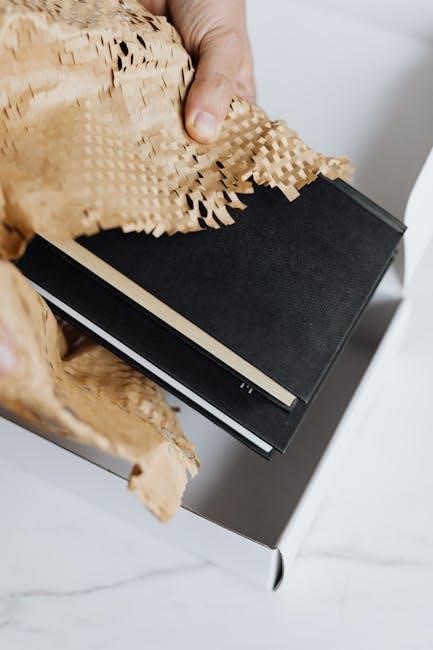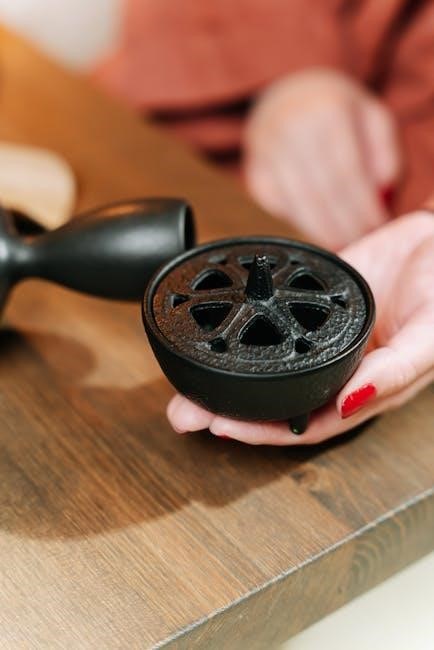Welcome to the Black and Decker Small Refrigerator Manual, your guide to understanding and maintaining your compact refrigerator. This manual provides essential information for safe operation, optimal performance, and troubleshooting, ensuring you get the most out of your appliance.
1.1 Overview of the Manual’s Purpose and Structure
This manual is designed to provide comprehensive guidance for the Black and Decker Small Refrigerator, ensuring safe and efficient use. It is structured to cover all aspects of the appliance, from installation to maintenance. The manual is divided into clear sections, including product specifications, operating instructions, safety precautions, and troubleshooting. Each section is tailored to address common questions and concerns, helping users maximize the performance and longevity of their refrigerator. By following this guide, you can ensure optimal functionality and troubleshoot issues effectively. This structured approach makes it easy to navigate and understand.
1.2 Importance of Reading the Manual for Optimal Use
Reading the Black and Decker Small Refrigerator Manual is crucial for optimal use and safety. It provides detailed instructions on proper installation, operation, and maintenance, ensuring your appliance functions efficiently. Understanding the manual helps prevent misuse, which can lead to malfunctions or safety hazards. Additionally, it highlights energy-saving practices and troubleshooting tips, extending the lifespan of your refrigerator. By following the guidelines, you can maintain performance, reduce energy consumption, and enjoy reliable cooling. Regularly reviewing the manual ensures you stay informed about best practices and any necessary adjustments, making it an essential resource for owners.

Product Specifications and Features
The Black and Decker Small Refrigerator offers compact dimensions, ample storage capacity, and energy-efficient design. It features a freezer, adjustable shelves, and a secure door seal for freshness.
2.1 Dimensions and Capacity of the Compact Refrigerator
The Black and Decker Small Refrigerator is designed to fit seamlessly into tight spaces. With dimensions tailored for compact use, it offers capacities ranging from 1.7 to 4.3 cubic feet, depending on the model. For instance, the BCRK17 model measures 17.5 x 19.4 x 31.4 inches, providing a 1.7 cu. ft. storage space, while the BCRK25B offers a 2.5 cu. ft. capacity. These sizes are ideal for small kitchens, dorm rooms, or offices, ensuring efficient storage without compromising on performance. The freezer compartment adds versatility, allowing users to store frozen items alongside fresh groceries. These dimensions and capacities make the appliance a practical choice for everyday needs, balancing space-saving design with functional storage solutions.
2.2 Key Features: Freezer, Shelves, and Door Design
The Black and Decker Small Refrigerator boasts a range of practical features designed for convenience and efficiency. Models like the BCRK25B include a compact freezer compartment, perfect for storing small frozen items. Adjustable shelves made of durable materials allow for customizable storage, while the door design often features built-in compartments for bottles, cans, and other essentials. Some units offer a reversible door, enhancing flexibility in placement. These features ensure optimal use of space and easy organization, making the appliance ideal for small kitchens, dorms, or offices. The combination of a freezer and versatile shelving provides ample storage for daily needs.
2.3 Energy Efficiency and Energy Star Certification
The Black and Decker Small Refrigerator is designed with energy efficiency in mind, earning the Energy Star certification for models like the BCRK25B and BCRK17. This certification ensures the appliance meets strict energy efficiency standards set by the U.S. Environmental Protection Agency. By using advanced insulation and smart cooling technology, these refrigerators consume less energy while maintaining consistent performance. This not only reduces your electricity bills but also supports eco-friendly practices. The Energy Star label guarantees that the product is environmentally responsible and cost-effective, making it a sustainable choice for everyday use.

Installation and Setup Guide
Ensure your Black and Decker Small Refrigerator is placed in a well-ventilated area, away from direct sunlight. Level the appliance for proper operation and plug it into a grounded outlet.
3.1 Choosing the Right Location for the Refrigerator
Proper placement is crucial for your Black and Decker Small Refrigerator. Ensure the unit is in a well-ventilated area to prevent overheating. Avoid direct sunlight, as it may affect performance. Keep the refrigerator away from heat sources like ovens or heaters. For optimal operation, maintain a distance of at least 2 inches from walls to ensure airflow. Do not place it in moisture-prone areas or extreme temperatures. If possible, position it on a level surface for stability. Built-in holders or stands can be used for elevated placement. Always refer to the manual for specific location guidelines.
3.2 Leveling the Appliance for Proper Operation
Proper leveling ensures your Black and Decker Small Refrigerator operates efficiently. Check the appliance’s base for adjustable legs or levelers. Use a spirit level to verify even placement. If necessary, adjust the legs by turning them clockwise or counterclockwise until the unit is stable. Ensure all legs touch the floor firmly to prevent wobbling. Tighten the legs securely after adjustment. Avoid placing the refrigerator on uneven surfaces, as this may affect cooling performance or cause noise. Leveling is crucial for proper door alignment and to prevent internal components from malfunctioning. Always refer to the manual for specific leveling instructions.
3.3 Connecting the Refrigerator to Power
To ensure safe and proper operation, plug the Black and Decker Small Refrigerator into a dedicated 120V electrical outlet. Avoid using extension cords or adapters, as they may cause electrical issues. Before connecting, verify that the outlet matches the refrigerator’s voltage requirements, typically 120V AC, 60Hz. Inspect the power cord for damage; if damaged, do not use the appliance. Once connected, ensure the refrigerator is turned on and functioning correctly. If you encounter any issues, consult the manual or contact Black and Decker customer support for assistance.

Operating Instructions
Learn to operate your Black and Decker Small Refrigerator effectively. Adjust the thermostat for desired temperatures, organize shelves for optimal storage, and ensure energy-efficient performance for daily use.
4.1 Setting the Temperature and Understanding the Thermostat
The thermostat in your Black and Decker Small Refrigerator allows precise temperature control. Locate the dial or button, typically found at the top or rear, and adjust to your desired setting. The recommended temperature for the fridge is between 37°F and 41°F, while the freezer should be set at or below 0°F. Avoid over-adjusting, as this can affect efficiency. Refer to the manual for specific guidance. Monitoring the temperature regularly ensures optimal performance and food safety. Adjustments may be needed based on external conditions or usage patterns.
4.2 Organizing and Storing Food Properly
Organizing your Black and Decker Small Refrigerator starts with understanding its compartments. Use the shelves and door storage for frequently accessed items like drinks and condiments. The freezer is ideal for long-term storage, so place meats, vegetables, and leftovers in labeled, freezer-safe containers. Keep raw meats at the bottom to prevent cross-contamination, and store fruits and vegetables in separate crisper drawers to maintain humidity. Dairy products and ready-to-eat items should be kept on middle shelves for consistent temperature. Use airtight containers to preserve freshness and prevent odors. Regularly clean and check door seals to ensure efficiency and food safety.
4.3 Defrosting and Maintenance Tips
Regular defrosting is essential to maintain your Black and Decker Small Refrigerator’s performance. Turn off the appliance and allow it to thaw naturally to avoid damaging the evaporator. Wipe down the interior with a mild detergent solution to prevent mold and odors. For maintenance, clean the condenser coils periodically to ensure proper airflow and energy efficiency. Check door seals for tightness and replace them if worn. Schedule annual professional inspections to address any hidden issues, ensuring your refrigerator runs smoothly and lasts longer.

Safety Precautions and Guidelines
Always unplug the refrigerator before cleaning or maintenance to avoid electrical hazards. Use child safety locks to prevent accidental opening. Avoid using harsh chemicals for cleaning to ensure safe operation and longevity.
5.1 Electrical Safety and Circuit Requirements
Ensure the refrigerator is plugged into a grounded electrical outlet rated for its power consumption. Avoid using extension cords, as they may cause overheating or fire hazards. The appliance should be installed on a dedicated circuit to prevent overloading. Never expose the refrigerator to water or moisture, as this can lead to electrical shock or malfunction. If you notice any damage to the power cord or plugs, discontinue use immediately. Always follow the manufacturer’s guidelines for electrical connections to ensure safe and efficient operation. Consult a qualified electrician if unsure about wiring or circuit compatibility.
5.2 Child Safety Features and Locking Mechanisms
The Black and Decker Small Refrigerator includes child safety features to prevent accidental access. A locking mechanism can be engaged to secure the door, ensuring children cannot open it. This feature is essential for safeguarding contents and avoiding potential hazards. To activate the lock, refer to the manual for specific instructions. Additionally, ensure the appliance is placed on a stable surface to prevent tipping. Regularly check the lock’s functionality to maintain its effectiveness. These safety measures help create a secure environment, especially in households with young children, while protecting the refrigerator from unintended use.
5.3 Handling and Avoiding Chemicals for Cleaning
When cleaning your Black and Decker Small Refrigerator, avoid using harsh chemicals like bleach or ammonia, as they can damage surfaces or leave harmful residues. Instead, use mild soap solutions or diluted white vinegar with a soft cloth. For tougher stains, a gentle scrubber may be used, but avoid abrasive materials that could scratch the interior or exterior. Always rinse surfaces thoroughly to remove any cleaning agent residue. Avoid spraying liquids directly onto electrical components. For the exterior, a damp microfiber cloth is recommended. Regular cleaning helps maintain hygiene and prevents odors, ensuring optimal performance and longevity of the appliance.

Troubleshooting Common Issues
This section helps identify and resolve common problems with your Black and Decker Small Refrigerator, such as temperature fluctuations or unusual noises, ensuring optimal performance.
6.1 Addressing Temperature Fluctuations
Temperature fluctuations in your Black and Decker Small Refrigerator can occur due to improper settings or external factors. First, ensure the thermostat is set correctly. If the issue persists, check for blocked vents or poor ventilation. Verify door seals are tight to prevent cold air from escaping. If the refrigerator is placed near a heat source, relocate it. For severe fluctuations, unplug the unit, let it rest, and restart. If problems continue, consult the troubleshooting guide or contact customer support for assistance. Regular maintenance and proper usage can help stabilize temperatures effectively.
6.2 Solving Noise or Vibrations from the Unit
If your Black and Decker Small Refrigerator produces unusual noise or vibrations, check the unit’s balance. Ensure it is placed on a level surface and adjust the leveling legs if necessary. A uneven base can cause vibrations. Verify that the refrigerator is not touching nearby objects, as this can amplify noise. If the issue persists, inspect internal components like the compressor or fan for malfunction. Refer to the troubleshooting guide in the manual for specific solutions. If the problem remains unresolved, contact Black and Decker customer support for professional assistance. Regular maintenance can help minimize such issues and ensure smooth operation.
6.3 Dealing with Ice Buildup or Freezer Malfunctions
If you notice excessive ice buildup in your Black and Decker Small Refrigerator, ensure the defrost drain is clear and functioning properly. Ice accumulation can reduce efficiency and damage components. Regular defrosting is recommended to maintain optimal performance. If the freezer is not cooling correctly, check the thermostat settings and ensure the door seals are tight. Avoid overloading the freezer, as this can impede airflow. If issues persist, consult the manual for troubleshooting steps or contact customer support for professional assistance. Proper maintenance can prevent ice buildup and ensure reliable freezer operation.

Maintenance and Cleaning Tips
Regularly clean the interior and exterior of your Black and Decker small refrigerator to maintain hygiene and efficiency. Check and replace worn-out parts, and schedule routine maintenance checks to ensure optimal performance.
7.1 Cleaning the Interior and Exterior Surfaces
Regular cleaning of your Black and Decker small refrigerator is essential for maintaining hygiene and performance. Use a mild detergent and warm water to wipe down interior surfaces, including shelves and compartments. Avoid abrasive cleaners or harsh chemicals that may damage finishes. For the exterior, a soft cloth and gentle cleaning product are recommended to prevent scratching. Dry all surfaces thoroughly after cleaning to prevent water spots. Additionally, check and clean the door seals to ensure proper sealing and energy efficiency. Regular cleaning helps maintain freshness and prolongs the lifespan of your appliance.
7.2 Checking and Replacing Parts (if applicable)
Regularly inspect your Black and Decker small refrigerator’s components to ensure optimal performance. Check shelves and door seals for damage or wear. If damaged, replace them promptly to maintain efficiency. For parts like the drain pan or leveling legs, ensure they are clean and functioning properly. If replacement is needed, use genuine Black and Decker parts for compatibility and safety. Always turn off the power before performing any maintenance. Refer to the manual or manufacturer’s website for specific instructions on replacing parts. Regular checks help prevent issues and extend the appliance’s lifespan.
7.3 Scheduling Regular Maintenance Checks
To ensure your Black and Decker small refrigerator operates efficiently, schedule regular maintenance checks every 1-3 months. Clean the drain pan and inspect the door seals for tightness. Check the shelves and wire racks for stability and cleanliness. Defrost the freezer compartment periodically to prevent ice buildup. Additionally, ensure proper ventilation around the unit by maintaining clearance from walls. Regular checks help identify potential issues early, reducing the risk of malfunctions. Refer to the manual for detailed guidance and keep a maintenance log to track your efforts. Consistent upkeep extends the appliance’s lifespan and performance.

Parts and Accessories Overview
Explore the essential components and optional accessories for your Black and Decker small refrigerator, including shelves, door seals, and drain pan. These enhance functionality and prolong lifespan.
8.1 Understanding the Components: Shelves, Door Seals, and More
The Black and Decker small refrigerator features adjustable shelves, sturdy door seals, and a drain pan for easy maintenance. These components ensure efficient storage and temperature control.
8.2 Optional Accessories for Enhanced Functionality
Optional accessories for your Black and Decker small refrigerator can enhance its functionality. These include additional shelves for better organization, door locks for security, and energy-monitoring devices. Accessories like a drain pan liner or a bottle holder can also improve convenience. Ensure compatibility with your specific model by checking the official Black and Decker website or authorized retailers. These extras can tailor your refrigerator to meet your unique needs, ensuring optimal performance and personalized use.
8.3 Replacing or Upgrading Parts
Replacing or upgrading parts on your Black and Decker small refrigerator can be done to maintain performance or enhance functionality. Common replacements include shelves, door seals, and thermostats. Always use genuine or compatible parts to ensure safety and efficiency. Refer to the manual or manufacturer’s website for part numbers and installation guides. Upgrading may involve adding features like advanced temperature controls or organizers. Contact Black and Decker customer support for assistance with parts replacement to ensure compatibility and proper installation. Regular maintenance and timely replacements will extend the appliance’s lifespan and reliability.

Warranty and Customer Support
Black and Decker offers a comprehensive warranty for your small refrigerator. For inquiries or issues, contact their customer support team via phone or email. Visit their website for detailed warranty terms, FAQs, and additional resources to ensure your product functions optimally.
9.1 Understanding the Warranty Terms and Conditions
Your Black and Decker compact refrigerator is covered by a limited warranty, ensuring protection against manufacturing defects. The warranty period varies by product, typically one to two years from purchase. It covers repair or replacement of defective parts, excluding wear and tear or misuse. To maintain warranty validity, retain your purchase receipt and follow all usage guidelines. For detailed terms, refer to the warranty section in your manual or visit the Black and Decker website. Understanding these terms ensures you can address any issues promptly and effectively.
9.2 Contacting Black and Decker Customer Service
For assistance with your Black and Decker small refrigerator, contact customer service via phone, email, or the official website. Visit www.blackanddecker.com/instantanswers for quick solutions. Phone support is available during business hours, and emails are typically responded to within 24-48 hours. Ensure you have your model number and purchase details ready for efficient service. For urgent issues, call the toll-free number listed in your manual. Additionally, the website offers a comprehensive FAQ section to address common concerns. Reach out for troubleshooting, warranty inquiries, or parts replacement to maintain your appliance effectively.
9.3 Accessing Online Resources and FAQs
Visit the official Black and Decker website for comprehensive online resources and FAQs. Downloadable manuals, such as the BCRK32 Manual and BCRK17 Manual, provide detailed guides for your compact refrigerator. The FAQs section addresses common questions about operation, troubleshooting, and maintenance. Regular updates ensure you have the latest information to optimize your appliance’s performance and resolve any issues efficiently.

Environmental Considerations
Black and Decker promotes environmental responsibility through Energy Star certification, energy-saving practices, and proper disposal guidelines, ensuring eco-friendly use and recycling of your small refrigerator.
10.1 Proper Disposal of the Appliance
Proper disposal of your Black and Decker small refrigerator is crucial for environmental protection. Always follow local regulations and guidelines for appliance disposal. Recycle whenever possible, as refrigerators contain materials like steel, plastic, and refrigerants that require special handling. Remove doors and shelves to prevent accidents and ensure safety. Check with local recycling centers or waste management agencies for designated drop-off locations. Proper disposal helps reduce landfill waste and prevents harmful substances from entering the environment. Eco-friendly disposal supports sustainability and responsible waste management practices.
10.2 Recycling Options for Old Refrigerators
Recycling your old Black and Decker small refrigerator is an eco-friendly way to dispose of it. Many recycling centers accept appliances and responsibly handle materials like steel, plastic, and refrigerants. Check with local waste management agencies or recycling facilities for drop-off locations. Some communities offer special collection events for large appliances. Before recycling, ensure doors and hazardous materials are removed. Additionally, retailers or manufacturers may provide recycling programs. Recycling helps conserve resources, reduces landfill waste, and supports sustainable practices. Always verify local regulations and requirements for appliance recycling in your area.
10.3 Energy-Saving Practices for Eco-Friendliness
Adopting energy-saving practices with your Black and Decker small refrigerator helps reduce environmental impact. Set the thermostat to optimal temperatures to avoid excessive cooling. Keep the fridge away from direct sunlight and heat sources to minimize energy use. Regularly defrost the freezer to maintain efficiency. Ensure the door seal is tight to prevent cold air from escaping. Clean condenser coils periodically to improve performance. Use the freezer compartment wisely to store items at their coldest needs. By following these tips, you contribute to energy conservation and lower your electricity bills while prolonging the appliance’s lifespan.
